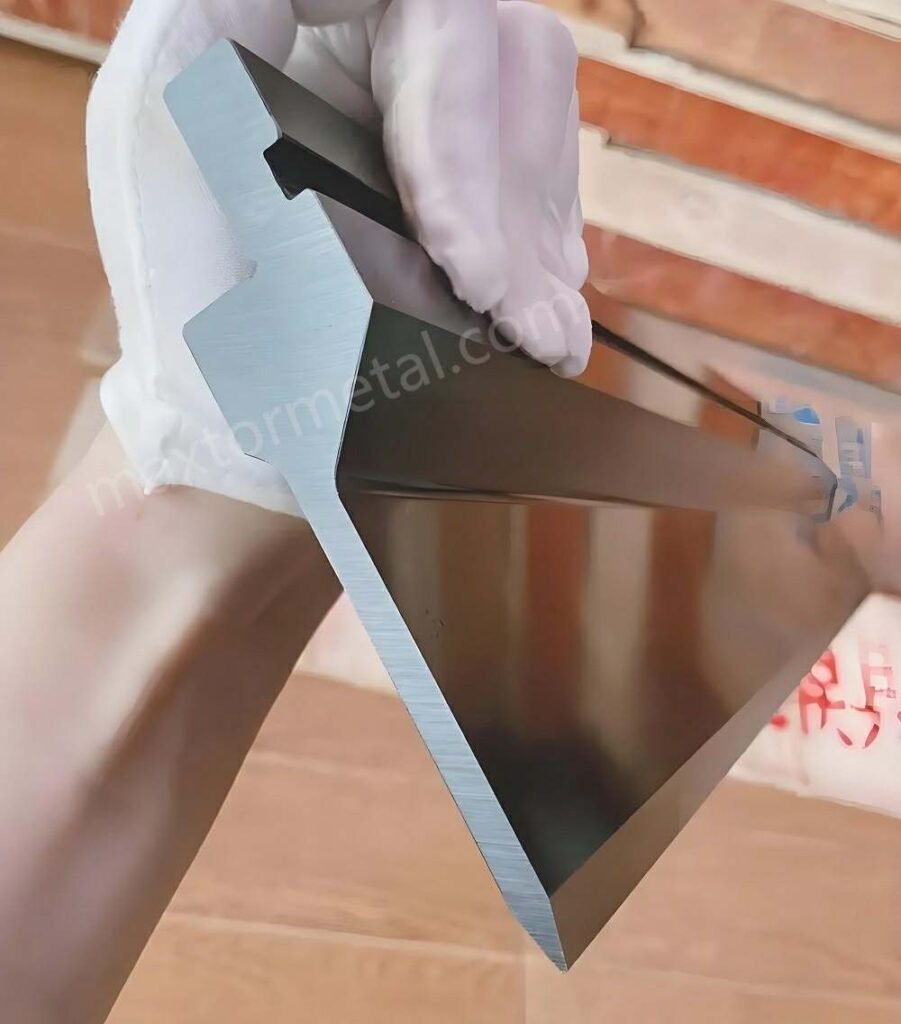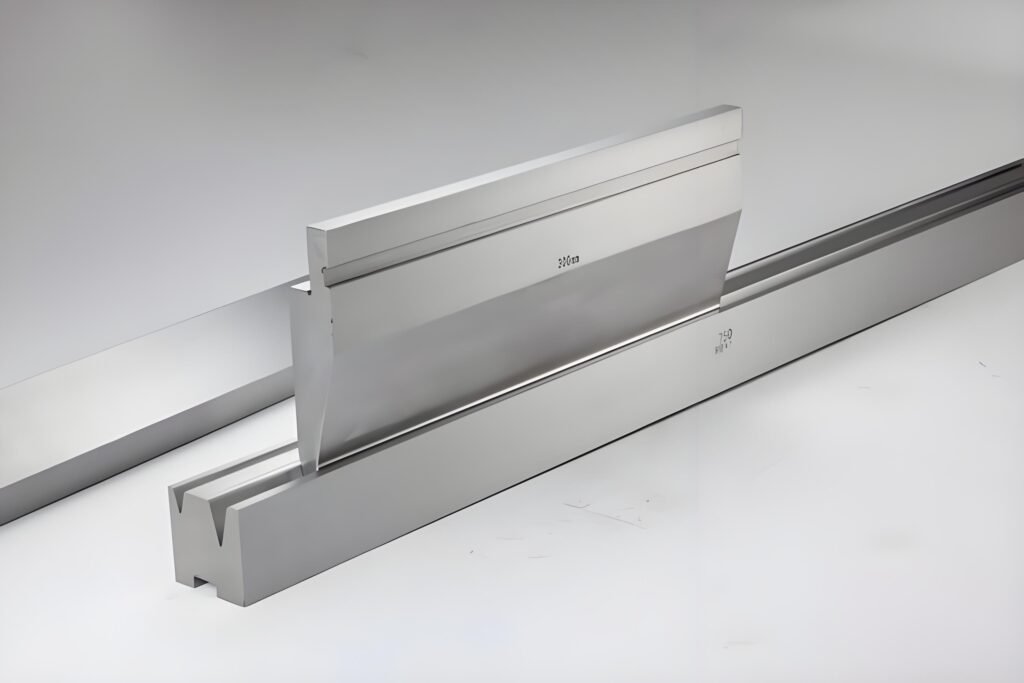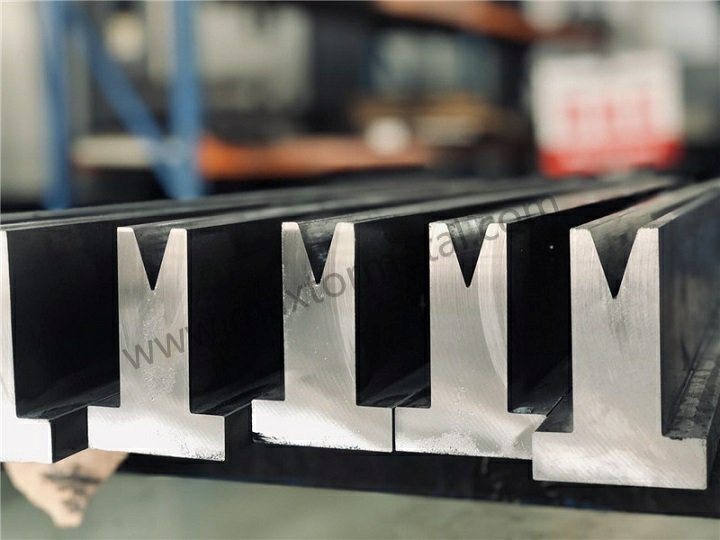
ए प्रेस ब्रेक पंच यह एक आवश्यक औद्योगिक मशीन ब्लेड है जिसका उपयोग प्रेस ब्रेक मशीन में शीट धातु को सटीकता के साथ आकार देने और मोड़ने के लिए किया जाता है। नानजिंग Metal उच्च-गुणवत्ता वाले प्रेस ब्रेक पंच बनाने में विशेषज्ञता, जो प्रेस ब्रेक डाई के साथ मिलकर धातु की चादरों में सटीक मोड़ बनाने में मदद करते हैं। कई कारखाने कारों, उपकरणों और इमारतों के पुर्जे बनाने के लिए नानजिंग Metal के कस्टम ब्लेड पर निर्भर हैं। वैश्विक प्रेस ब्रेक बाज़ार $ तक पहुँच गया है।2022 में 568.2 मिलियन और जैसे-जैसे कंपनियाँ बेहतर दक्षता और सुरक्षा की तलाश में हैं, यह लगातार बढ़ रहा है। जो लोग अपनी धातु झुकने की प्रक्रियाओं को बेहतर बनाने में रुचि रखते हैं, कृपया उनके उन्नत प्रेस ब्रेक पंच समाधानों के बारे में अधिक जानने के लिए नानजिंग Metal से संपर्क करें।
चाबी छीनना
- प्रेस ब्रेक पंच शीट धातु को डाई में दबाकर आकार देते हैं, जिससे ऑटोमोटिव और निर्माण जैसे कई उद्योगों के लिए सटीक मोड़ तैयार होते हैं।
- सही पंच का चयन धातु के प्रकार, मोटाई और मोड़ के कोण पर निर्भर करता है ताकि मजबूत, सटीक मोड़ सुनिश्चित हो सके और मशीन की सुरक्षा हो सके।
- नियमित रखरखाव, जिसमें सफाई, स्नेहन और निरीक्षण शामिल है, पंच का जीवनकाल बढ़ाता है और झुकने के परिणाम को सुसंगत और सुरक्षित रखता है।
- कस्टम प्रेस ब्रेक पंच निर्माताओं को जटिल आकृतियों और अद्वितीय सामग्रियों को संभालने में मदद करते हैं, जिससे दक्षता में सुधार होता है और अपशिष्ट कम होता है।
- मशीनों के लिए उचित टन भार और मिलान वाले पंचों का उपयोग करने से क्षति से बचाव होता है, सुरक्षा बढ़ती है, तथा उच्च गुणवत्ता वाली धातु निर्माण सुनिश्चित होता है।
प्रेस ब्रेक पंच की मूल बातें
परिभाषा और उपनाम
ए प्रेस ब्रेक पंच प्रेस ब्रेक मशीन में उपयोग के लिए डिज़ाइन किया गया एक विशेष औद्योगिक मशीन ब्लेड है। यह उपकरण धातु की चादरों को एक उपयुक्त डाई में दबाकर उन्हें आकार देता है और मोड़ता है। लोग कभी-कभी इन पंचों को उनके आकार या कार्य के आधार पर अलग-अलग नामों से पुकारते हैं। नीचे दी गई तालिका में उनके सामान्य प्रकार, उनकी तकनीकी परिभाषाएँ और प्रलेखित उपनाम दिए गए हैं:
| पंच प्रकार | तकनीकी परिभाषा | प्रलेखित उपनाम |
|---|---|---|
| मानक पंच | सबसे अधिक उपयोग किया जाने वाला पंच; संकरी नोक और बड़े शरीर के कारण मोटी सामग्री को मोड़ता है; बाहर की ओर अंदर की ओर सपाट तथा छोटा अवतल वक्र। | एन/ए |
| जॉगल पंच | कोनों के चारों ओर मोड़ने के लिए विशेष उपकरण; पतली प्रोफ़ाइल; एस आकार के लिए उपयोगी; असामान्य और विशिष्ट। | Z-टूल |
| रेडियस टॉप पंच | गोलाकार नोक, तीक्ष्ण V के स्थान पर U-आकार का मोड़ उत्पन्न करती है; गोलाकार कोनों के लिए U-आकार के डाई के साथ प्रयोग किया जाता है। | एन/ए |
| संकीर्ण पंच | कम मोटाई, लंबाई में एक समान; जहां निकासी सीमित हो, वहां प्रयुक्त; वर्गाकार या बॉक्स प्रोफाइल को बंद करने के लिए लोकप्रिय। | तलवार का मुक्का |
| स्वान नेक पंच | विशेषीकृत यू प्रोफाइल को चिह्नित करने और बनाने के लिए प्रयुक्त; अद्वितीय आकार मुड़े हुए पैरों को टूलींग से टकराने से रोकता है; कम मजबूत तथा कम टन भार क्षमता वाला। | गूज़नेक पंच (विभिन्न) |
| तीव्र कोण पंच | लघु कोणीय झुकाव (30° या 60° तक); नुकीली नोक वाला मोटा शरीर; कभी-कभी तीव्र छिद्र कहा जाता है। | तीव्र घूंसे |
| सैश पंच | कोणीय टिप के साथ छोटा शरीर; मोड़ के चारों ओर मोड़ने की अनुमति देता है; आमतौर पर दरवाजे के चौखट और सैश के लिए उपयोग किया जाता है। | एन/ए |
ये उपनाम श्रमिकों और इंजीनियरों को प्रत्येक कार्य के लिए सही प्रेस ब्रेक टूलिंग की पहचान करने में मदद करते हैं।
यह काम किस प्रकार करता है
प्रेस ब्रेक पंच, प्रेस ब्रेक मशीन के ऊपरी वर्कटेबल, जिसे रैम या स्लाइडर भी कहा जाता है, पर लगाया जाता है। संचालन के दौरान, पंच नीचे की ओर गति करता है और शीट धातु को निचली टेबल पर लगे एक डाई में दबाता है। इस क्रिया से एक सीधी रेखा में एक सटीक मोड़ बनता है।
झुकने की प्रक्रिया में नियंत्रित दबाव डालने के लिए हाइड्रोलिक या यांत्रिक बल का उपयोग किया जाता है। ऑपरेटर विभिन्न आकार और कोण बनाने के लिए पंच और डाई को बदल सकते हैं। आधुनिक मशीनें, जैसे कि सीएनसी प्रेस ब्रेक या हाइड्रोलिक प्रेस ब्रेक, सटीक आयाम और कोण निर्धारित करने के लिए कंप्यूटर प्रोग्राम का उपयोग करती हैं। यह तकनीक प्रेस ब्रेक बनाने में सटीकता और दोहराव को बेहतर बनाती है।
प्रेस ब्रेक संचालन में प्रमुख चरण शामिल हैं:
- शीट धातु को निचले डाई पर रखना।
- पंच को वांछित मोड़ रेखा के ऊपर संरेखित करना।
- पंच को नीचे करने के लिए प्रेस ब्रेक मशीन को सक्रिय करना।
- धातु को आवश्यक कोण पर मोड़ने के लिए बल लगाना।
- पंच को ऊपर उठाना और तैयार भाग को निकालना।
सेंसर और गार्ड जैसी सुरक्षा सुविधाएँ उच्च दबाव वाले मोड़ के दौरान ऑपरेटरों की सुरक्षा करती हैं। सीएनसी और सीएडी सॉफ्टवेयर का एकीकरण जटिल आकृतियों और कई मोड़ों के लिए अनुमति देता है, जिससे यह धातु मोड़ने वाली मशीन कई उद्योगों के लिए उपयुक्त बन जाती है।
उद्योग में अनुप्रयोग
प्रेस ब्रेक पंच कई औद्योगिक क्षेत्रों में महत्वपूर्ण भूमिका निभाते हैं। कारखाने इनका उपयोग कारों, हवाई जहाजों, जहाजों और इमारतों के पुर्जे बनाने में करते हैं। दुनिया का सबसे बड़ा प्रेस ब्रेक, जिसकी क्षमता 5,500 टन है, एयरोस्पेस, ऑटोमोटिव, निर्माण, जहाज निर्माण और भारी मशीनरी जैसे उद्योगों में काम करता है। कुछ मशीनें 320 मिमी मोटी तक के कच्चे माल को संभाल सकती हैं, जो आधुनिक प्रेस ब्रेक टूलिंग की शक्ति और लचीलेपन को दर्शाता है।
स्वचालन ने प्रेस ब्रेक संचालन की दक्षता में सुधार किया है। स्वचालित टूल चेंजर वाली रोबोटिक प्रणालियाँ 24/7 निरंतर उत्पादन की अनुमति देती हैं। केस स्टडीज़ से पता चलता है कि पैनल बेंडर्स का उपयोग करने वाले कस्टम फिक्स्चर निर्माताओं ने उत्पादकता में 30% की वृद्धि की है। प्रोटोटाइप विकास कार्यशालाएँ विविध उत्पादन क्षमताओं को बनाए रखने के लिए प्रेस ब्रेक पर निर्भर करती हैं। ये उदाहरण आज के विनिर्माण जगत में प्रेस ब्रेक के व्यापक अनुप्रयोगों को उजागर करते हैं।
| उद्योग क्षेत्र | प्रयुक्त मशीन | नतीजा |
|---|---|---|
| कस्टम फिक्स्चर निर्माता | पैनल बेंडर | 30% उत्पादकता वृद्धि |
| प्रोटोटाइप विकास कार्यशाला | ब्रेक दबाएँ | विविध उत्पादन क्षमताओं को बनाए रखा |
सामान्य सामग्री
निर्माता प्रेस ब्रेक पंच मज़बूत और टिकाऊ सामग्रियों से बनाते हैं। टूल स्टील सबसे आम विकल्प है क्योंकि यह घिसाव को रोकता है और अपनी धार तेज़ बनाए रखता है। कुछ पंच अतिरिक्त मज़बूती के लिए कठोर स्टील या हाई-स्पीड स्टील का इस्तेमाल करते हैं। विशेष पंचों में मिश्र धातु स्टील का इस्तेमाल किया जा सकता है या कठिन कामों के लिए सतह उपचार किया जा सकता है। सामग्री का चुनाव प्रेस ब्रेक टूलिंग के प्रकार और बेंडिंग प्रक्रिया की ज़रूरतों पर निर्भर करता है।
टिप: प्रेस ब्रेक पंच के लिए सही सामग्री का उपयोग करने से उसका जीवन बढ़ता है और शीट मेटल झुकने के दौरान लगातार परिणाम सुनिश्चित होते हैं।
प्रेस ब्रेक टूलिंग के प्रकार

प्रेस ब्रेक टूलिंग इसमें कई आकार और डिज़ाइन शामिल हैं। प्रत्येक प्रकार का पंच झुकने की प्रक्रिया में एक विशेष उद्देश्य पूरा करता है। विभिन्न प्रकार के प्रेस ब्रेक इन पंचों का उपयोग विभिन्न प्रकार के धातु भागों को बनाने के लिए करते हैं।
मानक पंच
प्रेस ब्रेक टूलिंग में मानक पंच सबसे आम उपकरण हैं। ये शीट मेटल में बुनियादी मोड़ और आकृतियाँ बनाने में मदद करते हैं।
सीधे मुक्के
स्ट्रेट पंच हल्के स्टील, स्टेनलेस स्टील और एल्युमीनियम जैसी सामग्रियों में 90 डिग्री का मोड़ बनाते हैं। कारखाने सामान्य मोड़ने के कामों के लिए इनका इस्तेमाल करते हैं। प्रदर्शन जांच, जैसे कि बॉल पंच और शियर पंच परीक्षण, दिखाते हैं कि सीधे पंच विश्वसनीय परिणाम देते हैं। ये परीक्षण तन्य शक्ति और तन्यता जैसे गुणों को मापते हैं, जो विनिर्माण में गुणवत्ता नियंत्रण के लिए महत्वपूर्ण हैं।
गूज़नेक पंच
गूज़नेक पंच घुमावदार आकार के होते हैं। ये वर्कपीस को बिना नुकसान पहुँचाए गहरे मोड़ बनाने में मदद करते हैं। श्रमिक इनका उपयोग चैनल या बॉक्स बनाने के लिए करते हैं। ये पंच एचवीएसी, विद्युत बाड़ों और उपकरण निर्माण में आम हैं।
तीव्र कोण पंच
एक्यूट एंगल पंच तीखे मोड़ बनाते हैं, अक्सर 90 डिग्री से भी कम। ये सजावटी धातु के काम और सटीक पुर्जे बनाने के लिए उपयोगी होते हैं। इनका मोटा शरीर और नुकीला सिरा सटीक कोण बनाने में मदद करते हैं।
हेमिंग पंच
हेमिंग पंच में शीट मेटल को अपने ऊपर मोड़ दिया जाता है। इस प्रक्रिया से धातु के किनारे मज़बूत होते हैं। ऑटोमोटिव पैनल और शीट मेटल के दरवाज़ों के लिए अक्सर हेमिंग प्रक्रिया की ज़रूरत होती है।
त्रिज्या पंच
रेडियस पंच धातु को चिकने, गोल किनारों के साथ मोड़ते हैं। फ़र्नीचर निर्माता और आर्किटेक्ट घुमावदार हिस्से बनाने के लिए इनका इस्तेमाल करते हैं। गोल नोक धातु में दरारों को रोकने में मदद करती है।
विशेष पंच
विशेष पंच विशिष्ट मोड़ने के कार्यों को संभालते हैं। वे विशिष्ट आवश्यकताओं को पूरा करने के लिए विभिन्न प्रकार के प्रेस ब्रेक के साथ काम करते हैं।
ऑफसेट पंच
ऑफसेट पंच Z-आकार के मोड़ बनाते हैं। ब्रैकेट और सपोर्ट फैब्रिकेशन में अक्सर इन पंचों का इस्तेमाल किया जाता है।
यू-आकार के पंच
यू-आकार के पंच यू-चैनल बनाते हैं। निर्माण और फ़्रेमिंग के काम इन्हीं उपकरणों पर निर्भर करते हैं।
कस्टम प्रोफ़ाइल पंच
कस्टम प्रोफ़ाइल पंचों के आकार अनोखे होते हैं। एयरोस्पेस और कस्टम मशीनरी उद्योगों को अक्सर इन विशेष डिज़ाइनों की ज़रूरत होती है।
मल्टी-वी पंच
मल्टी-वी पंच कई मोड़ त्रिज्याएँ बना सकते हैं। लचीले विनिर्माण वातावरण में इन पंचों से लाभ होता है क्योंकि ये उपकरण परिवर्तन को कम करते हैं।
अनुप्रयोग क्षेत्र और सामग्री

मानक पंच
मानक पंच कई उद्योगों में कारगर साबित होते हैं। ये ऑटोमोटिव, उपकरण और निर्माण परियोजनाओं में मददगार होते हैं। तकनीकी दस्तावेज़ों से पता चलता है कि मानक पंच सटीक और दोहराए जाने योग्य परिणाम प्रदान करते हैं। कतरनी पंच परीक्षण और अन्य विधियां सामग्री परीक्षण और विनिर्माण में उनके मूल्य की पुष्टि करती हैं।
विशेष पंच
विशेष पंच उन कार्यों के लिए उपयुक्त होते हैं जिनमें विशिष्ट आकार या कई मोड़ों की आवश्यकता होती है। एयरोस्पेस, निर्माण और कस्टम मशीनरी जैसे उद्योग जटिल पुर्जों के लिए इन उपकरणों का उपयोग करते हैं।
सामान्य सामग्री
निर्माता ज़्यादातर मानक पंच टूल स्टील, कठोर स्टील या हाई-स्पीड स्टील से बनाते हैं। ये सामग्रियाँ घिसाव को रोकती हैं और अपनी धार तेज़ बनाए रखती हैं। विशेष पंचों में मिश्र धातु स्टील का इस्तेमाल किया जा सकता है या अतिरिक्त मज़बूती के लिए सतह उपचार किया जा सकता है। अध्ययनों से पता चलता है कि पंच का आकार और सामग्री का चुनाव तैयार हिस्से की मज़बूती और गुणवत्ता को प्रभावित करता है। उदाहरण के लिए, पंच की वक्रता और संघनन दबाव, टैबलेट निर्माण में परतों के जुड़ाव की क्षमता को बदल सकते हैं। सामग्री अनुकूलता यह प्लास्टिसिटी और भंगुरता जैसे गुणों पर निर्भर करता है, जो अंतिम उत्पाद की मजबूती को प्रभावित करते हैं।
नोट: सही पंच और सामग्री का चयन मजबूत, सटीक मोड़ और लंबे समय तक चलने वाले प्रेस ब्रेक टूलिंग को सुनिश्चित करने में मदद करता है।
प्रेस ब्रेक पंच का चयन
सामग्री और मोटाई
सामग्री के प्रकार
सही पंच चुनने की शुरुआत धातु के प्रकार को जानने से होती है। निर्माता अक्सर कार्बन स्टील के लिए Cr-Mo मिश्र धातु के पंच का इस्तेमाल करते हैं। स्टेनलेस स्टील के लिए कोबाल्ट-मिश्र धातु या कार्बाइड पंच सबसे अच्छे होते हैं। एल्यूमीनियम के पंच पर निशान पड़ने से बचने के लिए पॉलिश किए हुए पंच की ज़रूरत होती है। पंच की सामग्री को शीट धातु से मिलाने से नुकसान से बचाव होता है और पंच मज़बूत रहता है।
शीट की मोटाई पर विचार
शीट की मोटाई पंच के लिए आवश्यक बल को प्रभावित करती है। 0.5 से 2 मिमी तक की पतली शीटों के लिए तीखे, सटीक-ग्राइंड पंच की आवश्यकता होती है। 2 से 6 मिमी तक की मध्यम शीटों के लिए कठोर टूल स्टील पंच का उपयोग किया जाता है। 6 मिमी से अधिक मोटी शीटों के लिए प्रबलित कास्ट पंच की आवश्यकता होती है। नीचे दी गई तालिका दर्शाती है कि कैसे मोटाई के साथ पंच बल और ऊर्जा में परिवर्तन:
| विशेषता | शीट की मोटाई से संबंध | विवरण |
|---|---|---|
| अधिकतम पंच बल | मोटाई के साथ बढ़ता है | मोटी चादरों को संचालन के दौरान अधिक बल की आवश्यकता होती है |
| काम किया | मोटाई पर निर्भर | मोटी चादरों के लिए अधिक ऊर्जा की आवश्यकता होती है |
| पंच-चरण लंबाई | मोटाई के अनुपात में | मोटाई बढ़ने के साथ पंच चरण लंबा होता जाता है |
| लोचदार ढाल | मोटाई का कार्य | विभिन्न मोटाई के साथ पंच प्रतिक्रिया बदलती है |
पंच चयन पर प्रभाव
पंच का चुनाव सामग्री और मोटाई दोनों पर निर्भर करता है। पतले एल्युमीनियम के लिए उपयुक्त पंच मोटे स्टेनलेस स्टील के लिए उपयुक्त नहीं हो सकता। निर्माता के विनिर्देश और उद्योग मानक इन विकल्पों का मार्गदर्शन करते हैं। सही पंच का उपयोग करने से झुकने की गुणवत्ता में सुधार होता है और दोष कम होते हैं।

मोड़ कोण और संगतता
आवश्यक मोड़ कोण
हर मोड़ने वाले काम के लिए एक खास कोण की ज़रूरत होती है। कुछ पंच तीखे मोड़ बनाते हैं, जबकि कुछ चिकने वक्र बनाते हैं। ऑपरेटरों को ऐसा पंच चुनना चाहिए जो उस हिस्से के लिए ज़रूरी कोण से मेल खाता हो।
न्यूनतम मोड़ त्रिज्या
न्यूनतम मोड़ त्रिज्या धातु के प्रकार और मोटाई पर निर्भर करती है। कम त्रिज्या कठोर धातुओं को तोड़ सकती है। ऑपरेटर प्रत्येक ऑपरेशन के लिए सुरक्षित न्यूनतम त्रिज्या ज्ञात करने के लिए चार्ट की जाँच करते हैं या सॉफ़्टवेयर का उपयोग करते हैं।
टूलींग और मशीन संगतता
पंच प्रेस ब्रेक मशीन में फिट होने चाहिए। हाइड्रोलिक प्रेस ब्रेक और सीएनसी प्रेस ब्रेक मॉडल की अलग-अलग ज़रूरतें होती हैं। पंच मशीन के टन भार और आकार के अनुरूप होना चाहिए। सही फिटिंग से ऑपरेशन सुरक्षित और सटीक रहता है।
टूलिंग को एप्लिकेशन से मिलान करना
अनुप्रयोग परिदृश्य
विभिन्न उद्योग कई कार्यों के लिए प्रेस ब्रेक पंच का उपयोग करते हैं। उदाहरण के लिए, कारखाने इनका उपयोग कार के पुर्जे, उपकरण और भवन के फ्रेम बनाने में करते हैं। कुछ कार्यों में जटिल आकृतियों के लिए विशेष पंच की आवश्यकता होती है।
Industry-Specific Requirements
Studies show that matching the right tooling to each industry reduces injury risks and boosts productivity. For example:
- CNC press brake operations in tool manufacturing lower strain and cut risks.
- Automation in metal shops reduces repetitive motion injuries.
- Safety checks and employee feedback help choose the best tooling for each sector.
Practical Selection Tips
Operators should:
- Check manufacturer guidelines for punch and machine compatibility.
- Use tables and charts to match punch type to material and thickness.
- Consider production volume and maintenance needs.Tip: The right punch makes bending safer, faster, and more reliable.
प्रेस ब्रेक पंच प्रदर्शन
Tonnage and Load
Calculating Required Tonnage
Operators must calculate the correct tonnage before starting a press brake operation. Tonnage means the amount of force needed to bend metal. The right tonnage depends on the material type, thickness, die opening width, and punch radius. For example, stainless steel needs about 1.5 times more force than mild steel. Aluminum needs less, while titanium may need double the force. The table below shows how these factors affect tonnage:
| कारक | विवरण | Impact on Tonnage |
|---|---|---|
| Die Opening Width | 6-8x material thickness for mild steel | Reduces tonnage by up to 30% |
| Punch Radius | Sharp radii need more force | Rounded profiles lower force needed |
| द्रव्य का गाढ़ापन | Thicker sheets need more force | Directly increases required tonnage |
| सामग्री का प्रकार | Different metals need different multipliers | Stainless steel 1.5x, aluminum 0.55x, titanium 2x |
Load Distribution and Safety Margins
Proper load distribution keeps the press brake safe and extends tool life. Operators use test bends, force sensors, or software to check the force during operation. Safety margins help prevent overload. For example, using 20% more force than needed can reduce hydraulic seal life from five years to only eighteen months. Ram guides and frame bolts also wear out faster if the load is too high.
Factors Affecting Tonnage Selection
Several factors affect tonnage selection. These include the shape of the punch, the width of the die, and the type of metal. If operators use too little force, the bend may not form correctly. Too much force can damage the machine or cause safety risks. Accurate tonnage calculation keeps the operation safe and efficient.

रखरखाव
Routine Cleaning Procedures
Operators should clean press brake punches after each use. Removing dust and metal shavings prevents buildup. Clean tools work better and last longer.
Rust Prevention and Lubrication
Applying a light oil coating helps prevent rust. Lubrication reduces friction during operation. This keeps the punch moving smoothly and protects the surface.
Wear Inspection and Replacement Guidelines
Regular inspections help spot wear or cracks early. Operators should check for uneven edges or surface damage. Replace worn punches to keep bending results accurate and safe.
उपकरण जीवन
Factors Influencing Tool Life
Tool life depends on correct tonnage, proper maintenance, and material choice. Overloading or using the wrong punch shortens tool life.
Best Practices for Extending Tool Life
Operators should use the right punch for each job, follow cleaning routines, and avoid overloading. Storing punches in a dry place also helps.
सामान्य विफलता मोड
Common failures include cracks, chipped edges, and surface wear. Regular checks and proper use help prevent these problems.
कस्टम प्रेस ब्रेक पंच समाधान
अनुकूलन के लाभ
Custom press brake punches offer unique advantages for manufacturers with specialized needs. Companies that use customized tooling often see faster production cycles and less material waste. Liberty Systems reports that tailored press brake tooling maximizes efficiency and improves accuracy. These benefits of press brakes help factories meet strict quality standards and reduce costs over time. In one case, a fabrication shop used 3D-printed custom punches made from fiber-reinforced polymer. The shop produced tooling for 14-gauge steel in less than 48 hours at a fraction of the usual cost. This approach not only met performance requirements but also accelerated delivery and saved money. Customization allows manufacturers to match equipment to specific tasks, which supports higher productivity and better results.
Nanjing Metal Custom Punches
नानजिंग Metal stands out as a trusted industrial blades manufacturer in the industry. With 18 years of experience, the company has built a strong reputation for quality and reliability. Nanjing Metal employs a skilled design and manufacturing team that focuses on custom industrial blades for press brake machines. Many clients choose Nanjing Metal for their ability to deliver precise, durable, and innovative solutions. The company’s expertise ensures that each custom punch meets the exact requirements of the application. Industry recognition and positive feedback highlight the company’s commitment to excellence. Nanjing Metal continues to lead the way in custom press brake punch manufacturing.
When to Choose Custom
Manufacturers should consider custom press brake punches when standard tooling cannot achieve the desired results. Complex part shapes, tight tolerances, or unique materials often require a tailored solution. Custom punches provide the benefits of press brakes by enabling new designs and improving process efficiency. Companies that face frequent design changes or work with advanced materials gain the most from customization. Choosing a custom punch helps solve production challenges and supports long-term growth.
इच्छुक पाठक कृपया नीचे दिए गए लिंक पर क्लिक करें: संपर्क a sales engineer to discuss custom press brake punch solutions.
Press brake punches shape metal sheets with accuracy and strength. The right punch and careful maintenance ensure each bend meets strict quality standards. Industry feedback shows that matching punches and dies to each job keeps bends precise and reliable. Custom solutions help factories handle unique projects and improve results.
For specialized needs, manufacturers can trust a professional press brake punch manufacturer with proven experience. Interested readers may contact a sales engineer for expert support.

सामान्य प्रश्न
What is the main function of a press brake punch?
A press brake punch shapes and bends sheet metal by pressing it into a die. This tool helps create precise angles and forms in metal parts for many industries.
How often should operators inspect press brake punches?
Operators should check punches before each use. Regular inspections help find wear or damage early. This practice keeps the bending process safe and accurate.
Which materials work best with press brake punches?
Tool steel, hardened steel, and high-speed steel are common choices. These materials resist wear and keep a sharp edge. Some special punches use alloy steel for extra strength.
Can custom punches improve production efficiency?
Custom punches match unique project needs. They help reduce setup time and material waste. Many factories see faster production and better results with custom tooling.
Where can manufacturers find a reliable press brake punch supplier?
Many companies look for experienced press brake dies manufacturer with a strong reputation. For more information or to discuss custom solutions, interested readers can contact a sales engineer.
यह भी देखें
प्रेस ब्रेक टूलिंग में महारत हासिल करना: पंच और डाई वियर की पहचान कैसे करें और उसे कैसे ठीक करें
लंबे समय तक चलने वाले उपकरणों के लिए प्रेस ब्रेक टूलिंग रखरखाव युक्तियाँ
कस्टम प्रेस ब्रेक टूलिंग आपकी विनिर्माण दक्षता को कैसे बढ़ाती है
प्रेस ब्रेक टूलिंग का जीवनकाल बढ़ाने और स्थायित्व को अधिकतम करने के लिए 5 आवश्यक सुझाव


